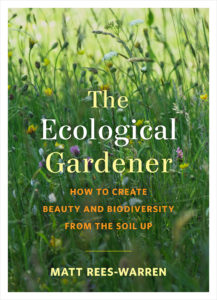 How to Create Beauty and Biodiversity from the Soil Up
How to Create Beauty and Biodiversity from the Soil Up
By Matt Rees-Warren
Reviewed by Molly Kerker
My plant collection is growing wild without intention, a hodgepodge of native plants given to me or rescued from colleagues and empty lots. It’s an odd assortment of recycled containers bursting with last year’s pawpaw seeds, rescued little bluestem, milkweed grown from seeds gathered from a nearby lot, and many more native plants that have fallen into my lap. While my garden may have a heart and is at times is buzzing with pollinators, it isn’t exactly well-planned.
Seeking intentionality in my gardening practice and hungry for new ideas, I picked up The Ecological Gardener: How to Create Beauty and Biodiversity from the Soil Up by Matt Rees-Warren. This well-organized book provides a very clear philosophy of ecological gardening, along with many helpful tutorials and ideas.
The book begins with an overview of design. Rees-Warren reviews design principles and gives helpful tips for beginners. For example, there are detailed instructions (with images) for creating an outline drawing, testing your soil, and marking out a path. What struck me most, however, was how this chapter called for a paradigm shift. When it comes to garden design, the balance has been tilted for too long towards aesthetics and away from ecological considerations. Rees-Warren invites us to become comfortable with the lack of neatness and order that comes with rewilding.
Subsequent chapters focus on soil, plant selection, water, and wildlife. It was fun to peruse these pages for ideas. The detailed instructions (with photos) for making and using a bokashi bin were inspiring. Other great tutorials include making your own biochar, constructing a whisky-barrel rain collector, building a keyhole garden, and creating a hessian-sack vertical garden. As he outlines these techniques, Rees-Warren entreats us to think of gardening as working for the natural world, not against it. All should be in the service of biodiversity and a healthy climate. Materials and labor are factored into the concept of ecological gardening as well. For example, Rees-Warren explains how to use a scythe (rather than a fossil fuel-powered tool) and how to grow and harvest a coppice—a collection of native trees planted for the sole purpose of harvesting their wood. He even gives tips on how to move towards a zero-plastic, no-waste future for our horticulture industry.
It’s worth noting that Rees-Warren is based in the United Kingdom. For someone such as myself living in the northeastern United States, it’s best to skip his plant lists. I’m still ruminating on the fact that purple loosestrife is listed as a recommended plant, while Virginia creeper is derided as an overly planted, non-native invasive. It’s always a trip to remember that our under-appreciated native plants are considered exotic ornamentals across the pond!
As someone who works at a botanic garden, perhaps the most impactful part of this book for me was the acknowledgment of the role of public gardens and parks. These spaces serve as inspiration to the home gardener—and have a ripple effect on what is available at nurseries. I’d like to believe the layperson has an impact too. My neighbors and friends have seen my plucky garden and are now asking me for advice to start their own rewilded gardens. With the guiding philosophies and clever ideas of The Ecological Gardener in my back pocket, I certainly feel more prepared for this worthy task.
About the Reviewer
Molly Kerker is Manager of Continuing Education at Brooklyn Botanic Garden. Educated at SUNY Geneseo (BA, English and Sociology) and Brown University (MA, Public Humanities), Molly’s mission is to connect people to the natural world and one another through shared experiences of wonder. Before assuming her current role at Brooklyn Botanic Garden, Molly’s passion for education and plants took her across the Northeast, as she filled roles such as coordinator of the Institute for Comparative Modernities at Cornell University, educator at the Haffenraffer Museum of Anthropology at Brown University, and food outreach/community garden coordinator at Catholic Charities of Livingston County. Molly is a birder, musician, and caretaker of a growing collection of native plants outside her apartment in Brooklyn, NY.
***
Each author appearing herein retains original copyright. Right to reproduce or disseminate all material herein, including to Columbia University Library’s CAUSEWAY Project, is otherwise reserved by ELA. Please contact ELA for permission to reprint.
Mention of products is not intended to constitute endorsement. Opinions expressed in this newsletter article do not necessarily represent those of ELA’s directors, staff, or members.

 How to Create Beauty and Biodiversity from the Soil Up
How to Create Beauty and Biodiversity from the Soil Up